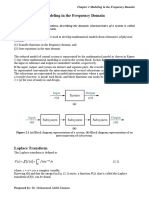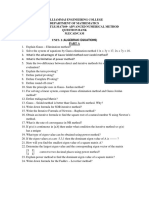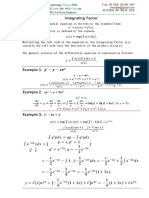My Laplace Table
My Laplace Table
Uploaded by
shivesh211204Copyright:
Available Formats
My Laplace Table
My Laplace Table
Uploaded by
shivesh211204Copyright
Available Formats
Share this document
Did you find this document useful?
Is this content inappropriate?
Copyright:
Available Formats
My Laplace Table
My Laplace Table
Uploaded by
shivesh211204Copyright:
Available Formats
Formula for the use of Laplace Transforms to Solve
Second Order Differential Equations.
Given the differential equation
ay ' 'by 'cy g (t ), y (0) y 0 , y' (0) y0'
we have
(as b) y 0 ay 0 ' L( g (t ))
L( y )
as 2 bs c
We get the solution y(t) by taking the inverse Laplace transform.
The following table are useful for applying this technique.
Table of Laplace Transforms
Definition of Laplace transform
L{ f (t )} e st f (t )dt
0
1
f (t ) L {F ( s )} F ( s) L{ f (t )}
Laplace transforms of elementary functions
1 1
s
n
t n!
s n 1
ta (a 1)
s a1
e at 1
s a
sin kt k
s 2 k 2
cos kt s
s 2 k 2
sinh kt k
s 2 k 2
cosh kt s
s 2 k 2
First translation and derivative theorems
at
e f (t ) F ( s a)
t n f (t ) dn
(1) n
F ( s)
ds n
f ' (t ) sF ( s) f (0)
f ' ' (t ) s 2 F ( s ) sf (0) f ' (0)
f ' ' ' (t ) s 3 F ( s ) s 2 f (0) sf ' (0) f ' ' (0)
Unit step and Dirac delta function
u (t a ) e as
s
f (t )u (t a ) e as
L{ f (t a )}
f (t a )u (t a) e as F (s )
(t a) e as
Convolution theorem and Laplace transform of a periodic function
t F ( s)G (s)
f g f () g (t )d
0
f (t ) f (t p ) 1
p
f (t )e
st
dt
1 e sp 0
You might also like
- Chapter 10: Solution of Partial Differential Equations (PDE's) Using Hankel TransformsNo ratings yetChapter 10: Solution of Partial Differential Equations (PDE's) Using Hankel Transforms15 pages
- Ekt 119 Chapter 2 Introduction To The Laplace TransformNo ratings yetEkt 119 Chapter 2 Introduction To The Laplace Transform27 pages
- Laplace Transforms: Spsu Mathematics DepartmentNo ratings yetLaplace Transforms: Spsu Mathematics Department37 pages
- Lecture 7 - Introduction To The Laplace TransformNo ratings yetLecture 7 - Introduction To The Laplace Transform6 pages
- Laplace Transform: Presentation: He YangNo ratings yetLaplace Transform: Presentation: He Yang14 pages
- Laplace Transform Properties: EE3511: Automatic Control SystemsNo ratings yetLaplace Transform Properties: EE3511: Automatic Control Systems47 pages
- Second Order Differential Equation: Laplace Transform - Inverse Laplace TransformNo ratings yetSecond Order Differential Equation: Laplace Transform - Inverse Laplace Transform8 pages
- Lec - 3-4 - Transfer Function and Laplace TransformNo ratings yetLec - 3-4 - Transfer Function and Laplace Transform54 pages
- Laplace Transforms: Reference: Differential Equations With Boundary-Valued Problems by Zill & Cullen 7 EditionNo ratings yetLaplace Transforms: Reference: Differential Equations With Boundary-Valued Problems by Zill & Cullen 7 Edition45 pages
- Excellent Does Not An Accident, But It Comes Through A Hard Work!!No ratings yetExcellent Does Not An Accident, But It Comes Through A Hard Work!!108 pages
- School of Engineering Engineering Mathematics 4 (MTH60403/ENG2123)No ratings yetSchool of Engineering Engineering Mathematics 4 (MTH60403/ENG2123)53 pages
- Modeling and Simulation MEIE5121/MCTE4150 Time ResponseNo ratings yetModeling and Simulation MEIE5121/MCTE4150 Time Response31 pages
- 33laplace Transforms and Non Standard Functions PDFNo ratings yet33laplace Transforms and Non Standard Functions PDF4 pages
- 08.04 - Runge-Kutta 2nd Order Method For ODE100% (1)08.04 - Runge-Kutta 2nd Order Method For ODE10 pages
- 110.302 Differential Equations Professor Richard BrownNo ratings yet110.302 Differential Equations Professor Richard Brown2 pages
- Part Seven: Ordinary Differential EquationsNo ratings yetPart Seven: Ordinary Differential Equations7 pages
- Full Download Nonlinear Partial Differential Equations for Scientists and Engineers Second Edition Lokenath Debnath PDF DOCX100% (6)Full Download Nonlinear Partial Differential Equations for Scientists and Engineers Second Edition Lokenath Debnath PDF DOCX50 pages
- 105-1 Differential Equation Solutions - v2No ratings yet105-1 Differential Equation Solutions - v212 pages
- Tutorial Problems #4: MAT 292 - Calculus III - Fall 2014No ratings yetTutorial Problems #4: MAT 292 - Calculus III - Fall 20145 pages
- Mr2597943 (2011C:35002) Fpartial Differential Equations.: 35-01 Evans, Lawrence C. (Evans, Lawrence Craig)No ratings yetMr2597943 (2011C:35002) Fpartial Differential Equations.: 35-01 Evans, Lawrence C. (Evans, Lawrence Craig)1 page
- Deriving Finite Element Equations Using Weighted Residual Method - Least Squares ApproachNo ratings yetDeriving Finite Element Equations Using Weighted Residual Method - Least Squares Approach17 pages
- 50434/Sm3Ae: Öuõøp°H SS Ö ºö - Í Ì Áõ Õmøh GêxpNo ratings yet50434/Sm3Ae: Öuõøp°H SS Ö ºö - Í Ì Áõ Õmøh Gêxp4 pages
- The Painlev e Methods (R. Conte and M. Mussette)No ratings yetThe Painlev e Methods (R. Conte and M. Mussette)29 pages
- 53124-mt - Numerical Methods For Partial Differential EquationNo ratings yet53124-mt - Numerical Methods For Partial Differential Equation2 pages
- Linear Differential Equations With Mathcad: Conference PaperNo ratings yetLinear Differential Equations With Mathcad: Conference Paper19 pages

























































































